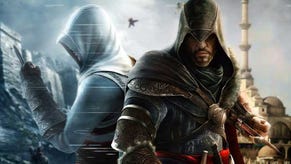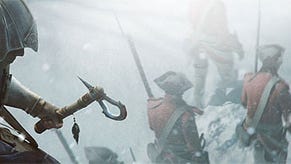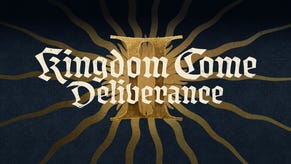The End: Three hours with Assassin’s Creed: Revelations
Stace Harman becomes an object of envy, going hands-on with Assassin's Creed: Revelations and schmoozing series writer Darby McDevitt.
Assassin’s Creed: Revelations marks the third title in the Assassin’s Creed 2 canon since 2009. Three titles: each with a lengthy single-player campaign, copious amounts of optional narrative exposition, side quests, a non-mandatory economic element and a well realised and popular multiplayer component. Is Ubisoft milking a cash cow or am I a curmudgeon staring into the gaping maw of a bemused gift horse?
Whilst the game-play-per-pound value for money that the Assassin’s Creed franchise represents cannot be quibbled with, those inclined towards narrative cognizance, but that may have missed any or all of the previous instalments since 2009’s Assassin’s Creed 2, are left facing something of a quandary over how to approach this latest instalment or whether to approach it at all.
Those without such concerns for the deeper machinations of the multi-faceted plot will likely have no problem jumping aboard, correctly assuming it to be the most feature rich of the three games and, undoubtedly, the game play mechanics are entertaining enough in themselves to reward such an approach.
However, those that want to indulge in the narrative details, soak up the historical context and unravel the conspiracy-laden tri-timeline plot might be curious as to how Ubisoft can hope to conclude a trilogy in such a way so as to reward those dutifully handing over their cash for a third time in two years without alienating those buying into the series for the first time.
“The first thing we try to do is keep the overarching present-day story involving Desmond fairly simple, moving the plot forward just slightly with each new game and then treating each of the ancestor stories as a self-contained narrative,” explains Assassin’s Creed Revelations lead writer, Darby McDevitt. “Then, when we come to do a new game we can do a ‘previously on Assassin’s Creed’ video that hopefully wraps up the basics of the story.
“As complex as the story might become, it’s always our aim that the player will know what they should be doing next - so if they’ve run around taking on lots of side-quests or have come back to the game after some time away, they at least know what the very next thing is they should be doing and where they need to go to do it.
“[The story] can get convoluted sometimes, but never so much that you become uninterested or lose the basic path.”
McDevitt, it seems, is confident that these tricks of the trade will serve to welcome old, new and plain forgetful players to the fold.
Old dog, new tricks
The hands-on consists of several hours spent with an aged and – bizarrely - simian-looking Ezio along with a flashback sequence with Altair. Split over the game’s opening half a dozen story sequences, whats on show introduces a number of new elements, both to keep things fresh and to prove that, despite now being at the top of his game as a master assassin and mentor, Ezio still has room to progress.
“Ezio’s progression starts with his introduction to new equipment,” says McDevitt. “The hook blade and bomb crafting are good examples of this – also, he has no armour because he left [at the end of Assassin’s Creed: Brotherhood] thinking he was going to be on vacation, so there’s room for him to acquire that and suit up from scratch.
“Primarily though, because he’s a mentor character, a lot of his progression happens outside of himself – so he can help recruit new assassins for the Ottoman Brotherhood, train them up to Master Assassin level and then go on missions with them ... as well as renovating parts of Constantinople. So, Ezio’s progression comes from these advancements because we very much want you to feel that you’re a master assassin when you start the game.”
The multi-purpose hook blade allows for cinematic – and speedy – traversal of the game’s huge cities, with the added benefit that Ezio can land an instant assassination as he dismounts from the zip-line. This quickening of getting from A to B makes the decision to include an instant fast-travel option between set points within a single city a curious one: fluid movement has been a ubiquitous joy of the Assassin’s Creed franchise and one of the principal columns on which the entire series is predicated; fast-travel seems to contradict that. The fact that it’s optional does little to ease the feeling that Ubisoft are concerned that its audience might be tiring of all this pesky parkour.
Bomb-crafting allows for the creation of three distinct flavours of bomb: lethal, tactical and diversionary and a new element of play revealed an interesting concept: strategic tower defence sections.
The hook-blade also comes into effect when scaling walls, effectively extending Ezio’s reach, and lastly it adds a handful of extra combat moves. Bomb-crafting allows for the creation of three distinct flavours of bomb: lethal, tactical and diversionary and a new element of play revealed an interesting concept: strategic tower defence sections.
During these new sections, Ezio remains at a fixed point overlooking an environment – in this case a city street lined with two-storey buildings - and you spend money to deploy assassin leaders on the roofs to which troops of varying types can be assigned, such as archers and, in time, riflemen. In the street below, barricades can be instantly constructed provided that you have the coin to pay for them and support fire from cannons can be called upon for a set fee.
Waves of attacking troops throw themselves against your defences, trying to reach your stronghold and their broken bodies can be looted to fund more troops against tougher waves of soldiers. It’s an unexpected but not unwelcome addition and adds yet another element to economic and building-management elements of the preceding two games.
Ciao, for now
As well as further developing Ezio’s character throughout the Revelations storyline, the added game play elements illustrate how Ubisoft is endeavouring to promote variety between Ezio and Altair’s sections.
“One of the key things was to give each of them different mission types, so we have some things that one does but not the other,” McDevitt explains. “Also, Altair only has the equipment that he had in Assassin’s Creed 1 so he just has the single blade for example because we’re staying true to who Altair is from the first game.”
“[Revelations] is primarily Ezio’s story with the Altair moments providing counter points to what’s going on with Ezio. So, he’s ruminating on his life in comparison to the huge swathe of Altair’s life – which ranges from him as a young man of 23 to an old man in his 90s. Ezio sees Altair go through these moments in his life and how they affect and change him – in doing so he wonders how much of Altair has had to endure is mirrored in his own life.
“I’ve tried not to be too didactic about these things, though, and I hope people will draw their own parallels and think about how it affects the story.
“The mandate for this game was to give Ezio and Altair an awesome send-off, and I think we’ve done that.”
The individual game play and narrative elements appear to be in place to provide it but a number of minor bugs, frozen animations and some isolated but fairly serious cases of pop-in present in the build I was given access to will need to be rectified before the game is buffed to its release-day sheen.
Though I wasn’t playing the final version, a couple of these irritants proved to be more than just aesthetic irregularities, affecting the game play quite significantly: having scoped out a path across a courtyard it was jarring to drop off the wall on which I was perched only for half a dozen guards to pop-in to view and immediately give chase.
With Ezio and Altair’s story concluding with Revelations, it’s all-but-confirmed that another instalment next year will tie up Desmond’s story. Perhaps after that, Ubisoft will take a step back from the series to consider everything it has accomplished in such a short space of time and to allow anticipation for future entries to build beyond a scant few months. That would be something of a revelation in itself; yet such churlishness seems once again to provoke the faint whinnying of a chastised gift horse.
For now though, it’s time to bid a fond farewell to master assassin and to raise a glass to his hard-earned retirement: cin-cin, Ezio.
Assassin’s Creed: Revelations launches on November 15 worldwide for PS3 and 360. The PC version has been delayed until later this year.
















.jpg?width=291&height=164&fit=crop&quality=80&format=jpg&auto=webp)



